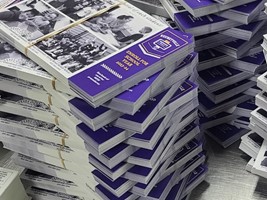Developing a comprehensive style guide for your print projects can be a game-changer, saving you precious time and avoiding unnecessary stress in the long haul.
Applying consistency and professionalism across all designs streamlines the process for you and your team, effortlessly facilitating the creation of top-notch materials.
Create an Effective Style Guide for Your Print Projects with Our 11 Tips for Success!
Creating a style guide can feel overwhelming, particularly when unsure where to begin.
Thankfully, with a few simple tips, you can craft an effective and efficient style guide to elevate your print projects to the next level.
1. Start with Your Brand Guidelines
Your brand guidelines are the foundation of your style guide.
They define your brand identity, including logos, colors, fonts, and messaging. Refer to your brand guidelines when creating your print project style guide.
2. Choose a Primary Font
Your primary font is the font that will be used for the majority of your text.
It plays a crucial role in shaping your brand's look and feel. It should be easy to read and carefully chosen to align with your brand's tone and personality, reflecting its unique essence and values.
3. Select Secondary Fonts
Secondary fonts are used for headings, subheadings, and other design elements.
Choose fonts that pair well with your primary font and add visual interest to your designs. Avoid using too many different fonts, which can create a cluttered and unprofessional look.
4. Define Your Color Palette
Your color palette should include colors that reflect your brand's personality and create a unified look for all your print projects.
Specify each color's EGB, CMYK, and HEX values for accurate printing. Consider limiting the number of colors to maintain consistency.
5. Determine Your Layout
Decide on the overall layout of your print projects, including the placement of images, text, and other design elements.
Establishing a specific layout will help create a cohesive look throughout all your materials.
6. Include Branding Elements
Your style guide should include a section for branding elements such as logos, taglines, and slogans.
Specify their correct usage and placement in your designs. This will ensure that your brand's identity is always represented accurately.
7. Set Guidelines for Images and Graphics
Specify the type of images and graphics that can be used in your print projects, as well as their quality and size.
This will ensure that all visuals are on brand and maintain a professional look.
8. Detail Typography Rules
Typography plays a significant role in design, so defining rules for font sizes, spacing, and kerning is essential.
Consistency in all your print materials is crucial for ensurng a cohesive and professional image.
9. Provide Examples
Visual examples are a great way to showcase how different elements should look in your designs.
Include examples of correct usage for fonts, colors, images, and layout to avoid confusion.
10. Define a Writing Style
If your print projects include written content, defining a writting style is crucial.
This should include spelling, grammar, and punctuation rules to ensure consistency in all your written materials.
11. Specify Print Specifications
Specify the print specifications for your projects, such as paper type, weight, finish, and trim size.
This will help ensure your materials are printed correctly and maintain a professional look.
Don't let inconsistent and unprofessional print materials hold your brand back! Make your brand shine with a well-defined style guide.
Contact us today start your next print marketing project!




